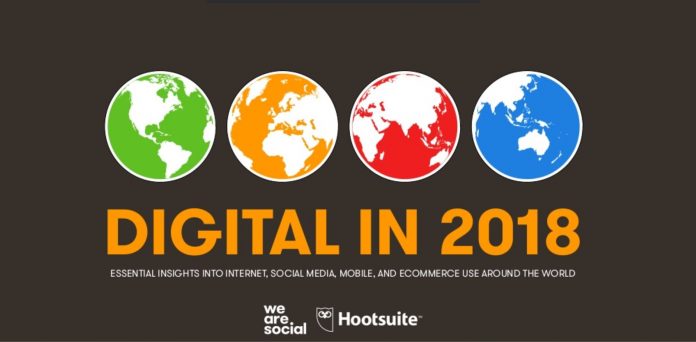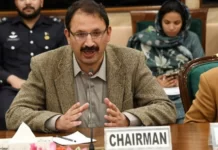
LAHORE: Global Digital report prepared by We Are Social and Hootsuite for Pakistan has revealed some fascinating insights about the country’s internet usage statistics, financial inclusion, annual digital growth, key indicators like active social media users etc.
According to the data compiled for the first three months of 2018 (Jan-March), the number of people using social media around the world rose by more than 100 million, touching roughly 3.3 billion by end of March 2018.
This comes in wake of increased privacy scandals which engulfed Facebook and got it incriminated in the Cambridge Analytica scandal, in which personal details of over 87 million users ended up being compromised.
For Pakistan, the active number of Facebook users stood at 35 million at end of January 2018, a 13 percent rise from the same period of last year.
The percentage of users declared as male on Facebook stood at 77 percent compared to a figure of 23 percent for females, revealed the report.
This may not be an accurate indicator to gauge Facebook usage by gender breakdown, but it does disclose the mainstream adoption of social media by females remains severely hampered.
Also, the percentage of users accessing Facebook via mobile was recorded at 91 percent for Pakistan.
The breakup of users in the age bracket of 13-17 stood at 4 million users with females comprising 3 percent and male’s 9 percent.
For the age bracket 18-24, female users shot up to 11 percent and male usage rose to 31 percent, indicating this segment of the population was using Facebook the most and were the most tech savvy of the lot.
For 25-34 age bracket, the user base stood at 11 million with females constituting 7 percent and males once again dominating this segment again.
With age brackets increasing, the percentage of female and male users using social media exhibited a significant decline with the number of users falling from 3,300,000 in 35-44 segment to a paltry 290,000 for people aged 65 and above for both genders.
A trend of major decline in Facebook usage for people in the age bracket of 35-44 is quite astonishing but is indicative of this segment of the population is still technology averse.
The “Average Facebook Engagement Rates” section is an indicator of the number of people who engage with a Facebook page’s posts vs. the number of people that those posts reach.
It reveals average engagement rate for all Facebook page posts (all types) stands at 2.04 percent, average engagement for FB page video posts at 7.27 percent, average engagement rate for FB page photo posts 7.36 percent, average engagement for FB page link posts 3.51 percent and average engagement for FB page status posts at 5.12 percent.
Instagram usage statistics from the report reveal the total number of active users on the network stands at 5.20 million and active Instagram users as a percentage of the total population were recorded at 3 percent.
A significant disparity once again arises in the male vs female demographics of users on Instagram. As per the report, 69 percent of users were males and 31 percent user’s females.
Also, from the figures available above for both Facebook and Instagram reveal the latter is the preferred medium of social media usage for females with the male gender dominating both.
The “financial inclusion factors” section takes into consideration the percentage of the population aged 15+ that reports owning or using each financial product or service.
As per the breakdown in this section, people with a bank account stand at 13 percent and those having a credit card was abysmal with 0.1 percent.
And people making or receiving mobile payments via GSMA stood at 6 percent, with those making online purchases or paying online bills was recorded at a meager 2 percent.
The percentage of men and women having a credit card didn’t represent much disparity, as it was recorded at 0.2 percent and 0.1 percent respectively.
Percentage of both genders making internet payments stood at 0.4 percent for females and 3 percent for males respectively.
The low percentage of financial inclusivity is something that has also been acknowledged by the State Bank of Pakistan, for which a National Financial Inclusion Strategy was formally launched and adopted by the government in May 2015.
But the statistics provided in the report could be inaccurate since the figures provided are based on World Bank Global Financial Inclusion Data 2015, which is almost three years old.
In a comment to Pakistan Today, Faiza Yousaf, Founder – WomenInTechPK and Chief Consultant Outtabox said “The reason behind women using less social media is that a lot of them are not financially independent and owning a smartphone requires money and in a lot of cases permission from the men in the house.
“Women are also restricted to use social media by males in the family due to the fear of harassment and in some cases religious/cultural reasons.”
These is a huge percentage of women using shared accounts with their husbands just because they don’t feel like revealing their identity online.”
Globally, all things digitals posted a strong growth during the first quarter of 2018, according to the report.
The number of internet users posted an increase of 276 million during the first quarter (January-March) of 2018, touching a total of 4.087 billion users.
5 billion people globally are now globally using a mobile phone and 6 in 10 users approximately owning a smartphone.
Interestingly, mobile keeps on increasing its share of social media use with reportedly 389 million people using social media via mobile for first during Jan-March 2018.























If female dominance was to be seen, then statistics should have been taken for Snapchat usage, where I’m pretty sure females dominate males population. The use of all the stupid filters is common only in one gender.
[…] inequality there. Over the past year, Pakistan contributed 35 million new accounts to Facebook with more than three-quarters of those users being […]
[…] inequality there. Over the past year, Pakistan contributed 35 million new accounts to Facebook with more than three-quarters of those users being […]
Comments are closed.